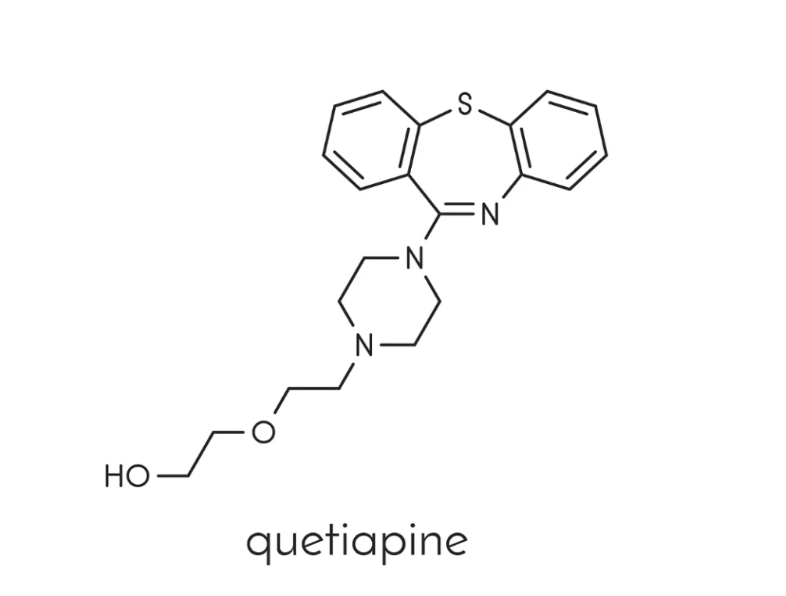Does CBD interact with quetiapine?
Cannabidiol (CBD) is one of the main compounds in the Cannabis sativa plant. The use of CBD has skyrocketed in recent years due to its wide range of health benefits.
However, CBD can lead to complications when taken together with other drugs such as quetiapine (Seroquel).
Learn how CBD and quetiapine could interact and whether you should avoid this combination.
Does CBD interact with quetiapine?
The combination of CBD with antipsychotic drugs such as quetiapine (Seroquel) poses a low to moderate risk.
The main problems with this combination are the increased effect of quetiapine (leading to side effects) and metabolic interactions (slowed breakdown of both compounds). Thus, the greatest risk comes from the long-term combined use of quetiapine and CBD.
With intermittent use of CBD (less than four days per week), adverse drug interactions are unlikely.
1. Increased effect (agonist interaction)
An agonistic interaction occurs when two or more substances show the same effect on the body. These drugs may act on the same or different receptors, but when taken together they produce certain effects in the same direction.
When CBD is taken together with quetiapine (Seroquel), its depressant effect on the central nervous system (CNS) and respiration may be additively or synergistically enhanced in patients, especially the elderly.
These two drugs mutually reinforce each other's effects, which could be so strong that they cause more harm than good.
Sedation and impairment of attention, judgment, thinking and psychomotor skills may also be more pronounced with this interaction.
Patients must be careful and should take these drugs together only under close supervision of a physician.
2. Metabolic inhibition (delayed elimination)
Most drugs are metabolized in the liver by a group of enzymes called the cytochrome P450 complex. Drug metabolism is the essential process by which these enzymes break down drugs into smaller metabolites that are excreted in the urine.
CBD and quetiapine (Seroquel) are metabolized by the same sets of these enzymes (primarily CYP3A4).
CBD may compete or interfere with these enzymes, resulting in a change in the concentration (either too low or too high) of Seroquel in the body. Such an interaction is called metabolic competition. This is the most common type of interaction between CBD and other drugs.
This effect is more pronounced with long-term use - so if you take CBD daily, metabolic inhibition could lead to higher serum levels of both substances. Eventually, this could lead to a tipping point.
Is it safe to take CBD and quetiapine (Seroquel) together?
The safety profile of CBD is well known, extensive clinical research has shown it to be safe and well tolerated, while rarely causing serious side effects.
It's not uncommon for patients to seek ways to combine CBD with antipsychotic medications such as quetiapine (Seroquel) because of the similar health benefits of both substances - particularly in treating depression, post-traumatic stress disorder (PTSD) and anxiety.
However, caution should always be exercised when using these drugs together, especially when taking them long-term.
Talk to your doctor about your intention to take CBD or other cannabinoids together with quetiapine. Your doctor will be able to give you more specific advice about your unique situation and may even want to reduce your quetiapine dose to account for the effects of CBD.
Is CBD a suitable alternative to quetiapine (Seroquel)?
CBD interacts with the endocannabinoid system (ECS), which is found throughout the body. It regulates many aspects of homeostasis (balance) - including temperature regulation, pain transmission, hormone levels, neurotransmission, satiety and more.
Some of these benefits could help regulate the underlying cause of depression or anxiety - it could be shown to work as an antidepressant and anxiolytic [1]. However, these effects are quite different from quetiapine (Seroquel).
For some people, CBD or other cannabinoids offer enough support to manage mild to moderate depression [2]. However, that doesn't mean it's equal to quetiapine, a potent antipsychotic that targets serotonin reuptake.
If you are already taking quetiapine, you need to check with your doctor before trying anything else.
Abrupt discontinuation of quetiapine in particular can lead to unwanted side effects - discontinue this medication slowly.
Secondly, quetiapine and other antipsychotics may take several weeks or months to work. Just because it doesn't work right from the start doesn't mean it doesn't do its job.
Common symptoms of quetiapine (Seroquel) withdrawal include:
- Nausea and vomiting
- Restlessness
- Agitation
- Diaphoresis
- Irritability
- Anxiety
- Dysphoria
- Sleep disturbances/insomnia
- Tachycardia
- Hypertension
- Dizziness
- Withdrawal dyskinesia: abnormal choreiform movements with confusion and speech impairment.
What is Quetiapine (Seroquel)?
Quetiapine is the name of the medicine Seroquel. It is a psychotropic medication from the group of "atypical antipsychotics" that is commonly prescribed to treat schizophrenia, bipolar disorder, and major depressive disorder.
Quetiapine (Seroquel), like other atypical antipsychotics, works by restoring the balance of certain neurotransmitters in the brain, such as dopamine and serotonin, by affecting the ability of these compounds to be reabsorbed into the neuron, where they are then destroyed.

Quetiapine (Seroquel) Specifications:
|
Name |
Quetiapine |
|
Trade name |
Seroquel, Seroquel XR, Tenprolide |
|
Other names |
Quetiapine |
|
Classification |
Atypical antipsychotics, benzothiazepines |
|
CYP metabolism |
CYP3A4 |
|
Interaction with CBD |
Agonistic (increased effects) |
|
Risk of interaction |
Mild to moderate |
What does quetiapine (Seroquel) do?
Quetiapine (Seroquel) is indicated for the treatment of schizophrenia and bipolar disorders. It is also used as an adjunct to other treatments for major depressive disorder.
In the human body, quetiapine works by affecting the release of neurotransmitters such as dopamine and serotonin, among others. Although the exact mode of action on the body is still under clinical study, various complex mechanisms may be involved.
The first mechanism is acting as an antagonist of dopamine D1 and D2 receptors.
Dopamine is a signaling molecule in the brain that plays an important role in motor control and thinking ability. Quetiapine binds to dopamine receptors, thereby preventing dopamine from binding to its receptor and interfering with its function.
Blocking the D2 receptor in various CNS pathways is indicated in the treatment of schizophrenia for negative and positive symptoms. Increased amounts of dopamine in these pathways are associated with schizophrenia.
Seroquel has a strong affinity for the serotonin (5-HT2) receptor. Its pharmacological action is mediated primarily by serotonin(5-HT2) receptor blockade. Inappropriate binding of serotonin, another signaling molecule in the brain, to the 5-HT2A receptor plays a role in psychiatric disorders such as schizophrenia and depression [3].
It is also possible that the anti-anxiety and antidepressant properties of quetiapine (Seroquel) and its active metabolite norquetiapine are due to the inhibitory potential of the norepinephrine transporter (NET) and partial agonist activity at the serotonergic 5 HT1A receptor, respectively.
Its antiserotoninergic properties are thought to mediate this antidepressant activity.
What are the side effects of quetiapine (Seroquel)?
As with all antipsychotics, quetiapine has an increased risk of death in dementia-related psychoses in elderly patients.
Likewise, the use of quetiapine produces a long list of adverse side effects.
Common side effects associated with quetiapine include:
- Abdominal discomfort
- Blurred vision
- Constipation
- Dizziness or lightheadedness
- Dry mouth
- Orthostatic hypotension
- Somnolence (drowsiness)
- Fatigue
- Increase in body weight
There are also some serious side effects associated with its use.
You should seek medical attention immediately if you develop the following symptoms after taking this medicine:
- Allergic reaction
- Constipation with persistent abdominal pain
- Difficulty urinating
- Dysphagia (difficulty swallowing)
- Enlarged breasts (men)
- Fainting, convulsions, severe dizziness
- Hyperglycaemia
- Hyperprolactinaemia
- Inability to produce sperm
- Neuroleptic malignant syndrome (NMS)
- Persistent nausea or vomiting
- Priapism (painful erection)
- Sleep apnoea
- Suicidal thoughts
- Tardive dyskinesia
- Yellowing of the eyes or skin
Patients must seek medical attention immediately if any such serious side effects occur after taking quetiapine (Seroquel).
Precautions for taking quetiapine (Seroquel)
The following issues should be discussed with your doctor when taking Seroquel for your medical condition:
1. Pregnancy
Quetiapine (Seroquel) is a category C medication for pregnancy. This means that its safety or effectiveness in pregnancy has not yet been established. Therefore, patients must inform their doctor if they become pregnant or plan to become pregnant before or during treatment.
2. Breastfeeding/lactation
Patients should refrain from breastfeeding if taking quetiapine as part of a treatment regimen.
3. Other medicinal products
If the patient is taking or plans to take any prescription or over-the-counter medications, this should be discussed with the physician because of the risk of possible interactions.
4. Orthostatic hypotension
The use of quetiapine carries a significant risk of developing orthostatic hypotension, particularly during the 3-5 day initial dose titration period and also at the time of re-initiation or dose escalation. These side effects should be aware of before initiating use of this product.
Key Finding: Is it safe to take Seroquel with CBD?
Quetiapine (Seroquel) and CBD may be effective in treating schizophrenia, mood disorders, and other mental illnesses. However, because the two drugs are metabolized by the same enzyme, they can easily interact with each other, which can lead to side effects.
If someone wants to take CBD alongside or in place of quetiapine, they must do so under the supervision of a doctor. While taking these drugs concurrently, patients should be monitored for possible excessive or prolonged CNS and respiratory depression.
Cautious dose titration may be necessary, especially at the beginning of treatment. Patients should avoid complex activities requiring mental alertness and motor coordination such as operating machinery, driving, etc. until they know how these substances affect them. Patients must inform their physician if they develop excessive or prolonged CNS effects that interfere with their normal activities.
References
- García-Gutiérrez, M. S., Navarrete, F., Gasparyan, A., Austrich-Olivares, A., Sala, F., & Manzanares, J. (2020). Cannabidiol: a potential new alternative for the treatment of anxiety, depression, and psychotic disorders. Biomolecules, 10(11), 1575.
- Bonaccorso, S., Ricciardi, A., Zangani, C., Chiappini, S., & Schifano, F. (2019). Cannabidiol (CBD) use in psychiatric disorders: a systematic review. Neurotoxicology, 74, 282-298.
- de Angelis, L. (2002). 5-HT2A antagonists in psychiatric disorders. Current opinion in investigational drugs (London, England: 2000), 3(1), 106-112.
